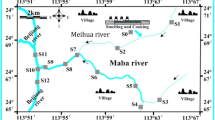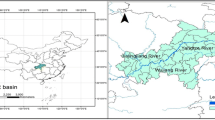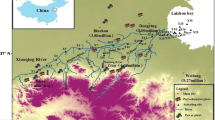Abstract
Ecological wastewater treatment plant (EWWTP), a kind of emerging wastewater treatment plant (WWTP) in recent years, combined microbiology with botany which is efficient for the removal of nitrogen and organic matter, as well as deodorization. The occurrence and removal of micro-organic pollutants in EWWTPs were still not well known. Polycyclic aromatic hydrocarbons (PAHs) and their typical derivatives (SPAHs) including the oxygenated PAHs (OPAHs), chlorinated PAHs (ClPAHs), and methyl PAHs (MPAHs) were investigated in an EWWTP in Guangdong Province, China. The concentrations of the Σ6 OPAHs (114–384 ng/L) were higher than the Σ16 PAHs (92–250 ng/L), and much higher than the Σ4 MPAHs (13–64 ng/L) and Σ9 ClPAHs (2–3 ng/L) in the EWWTP and the effluent receiving river. The total removal efficiencies of the PAHs, OPAHs, MPAHs, and ClPAHs in the EWWTP (43 ± 14%, 41 ± 7%, 55 ± 16%, and 18 ± 4%) were lower than the traditional WWTPs, probably due to the lower concentration of the sludge in the ecological treatment. The advanced treatment process (microfiltration and UV disinfection treatment) contributed much less (0–20%) to the whole removal efficiency than the ecological treatment (80–100%). The effluent from the EWWTP slightly reduced the PAHs and SPAHs concentrations in the receiving river. The high concentrations of the PAHs and SPAHs in the receiving river were similar to the influent of the EWWTP, indicating that some untreated wastewater was directly discharged to the river, especially in the upstream.







Similar content being viewed by others
References
An TC, Qiao M, Li GY, Sun HW, Zeng XY, Fu JM (2011) Distribution, sources, and potential toxicological significance of PAHs in drinking water sources within the Pearl River Delta. J Environ Monit 13:1457–1463
Bai YH, Huo Y, Liao KLL, Qu JH (2017) Influence of microbial community diversity and function on pollutant removal in ecological wastewater treatment. Appl Microbiol Biotechnol 101:7293–7302
Barrick RC (1982) Flux of aliphatic and polycyclic aromatic-hydrocarbons to Central Puget Sound from Seattle (Westpoint) primary sewage effluent. Environ Sci Technol 16:682–692
Bergqvist PA, Augulyte L, Jurjoniene V (2006) PAH and PCB removal efficiencies in Umea (Sweden) and Siauliai (Lithuania) municipal wastewater treatment plants. Water Air Soil Pollut 175:291–303
Bhatia AL, Tausch H, Stehlik G (1987) Mutagenicity of chlorinated polycyclic aromatic-compounds. Ecotoxicol Environ Saf 14:48–55
Manoli E, Samara C (1999) Occurrence and mass balance of polycyclic aromatic hydrocarbons in the Thessaloniki sewage treatment plant. J Environ Qual 28:176–187
Meng LA, Qiao M, Arp HPH (2011) Phytoremediation efficiency of a PAH-contaminated industrial soil using ryegrass, white clover, and celery as mono- and mixed cultures. J Soils Sediments 11:482–490
Mezzanotte V, Anzano M, Collina E, Marazzi FA, Lasagni M (2016) Distribution and removal of polycyclic aromatic hydrocarbons in two Italian municipal wastewater treatment plants in 2011-2013. Polycycl Aromat Compd 36:213–228
Moretti P, Choubert JM, Canler JP, Buffiere P, Petrimaux O, Lessard P (2018) Dynamic modeling of nitrogen removal for a three-stage integrated fixed-film activated sludge process treating municipal wastewater. Bioprocess Biosyst Eng 41:237–247
Murray KJ, Parker WJ, Bragg LM, Servos MR (2017) Fate of selected pharmaceutically active compounds in the integrated fixed film activated sludge process. Water Sci Technol 75:2680–2691
Ohura T (2007) Environmental behavior, sources, and effects of chlorinated polycyclic aromatic hydrocarbons. Sci World J 7:372–380
Ozaki N, Takamura Y, Kojima K, Kindaichi T (2015) Loading and removal of PAHs in a wastewater treatment plant in a separated sewer system. Water Res 80:337–345
Pham TT, Proulx S (1997) PCBs and PAHs in the Montreal Urban Community (Quebec, Canada) wastewater treatment plant and in the effluent plume in the St Lawrence river. Water Res 31:1887–1896
Qiao M, Qi WX, Liu HJ, Qu JH (2014) Occurrence, behavior and removal of typical substituted and parent polycyclic aromatic hydrocarbons in a biological wastewater treatment plant. Water Res 52:11–19
Qiao M, Qi WX, Zhao X, Liu HJ, Qu JH (2016a) Occurrence and removal of polycyclic aromatic hydrocarbons and their derivatives in typical wastewater treatment plants in Beijing. Environ Sci (In Chinese) 37:1451–1459
Qiao M, Qi WX, Liu HJ, Bai YH, Qu JH (2016b) Formation of oxygenated polycyclic aromatic hydrocarbons from polycyclic aromatic hydrocarbons during aerobic activated sludge treatment and their removal process. Chem Eng J 302:50–57
Qiao M, Cao W, Liu BC, Bai YH, Qi WX, Zhao X, Qu JH (2017) Impact of upgrading wastewater treatment plant on the removal of typical methyl, oxygenated, chlorinated and parent polycyclic aromatic hydrocarbons. Sci Total Environ 603:140–147
Qiao M, Bai Y, Cao W, Huo Y, Zhao X, Liu D, Li Z (2018) Impact of secondary effluent from wastewater treatment plants on urban rivers: polycyclic aromatic hydrocarbons and derivatives. Chemosphere 211:185–191
Ren YX, Nakano K, Nomura M, Chiba N, Nishimura O (2007) A thermodynamic analysis on adsorption of estrogens in activated sludge process. Water Res 41:2341–2348
Sanches S, Leitao C, Penetra A, Cardoso VV, Ferreira E, Benoliel MJ, Crespo MTB, Pereira VJ (2011) Direct photolysis of polycyclic aromatic hydrocarbons in drinking water sources. J Hazard Mater 192:1458–1465
Shon HK, Vigneswaran S, Snyder SA (2006) Effluent organic matter (EfOM) in wastewater: constituents, effects, and treatment. Crit Rev Environ Sci Technol 36:327–374
Sui Q, Huang J, Deng SB, Yu G, Fan Q (2010) Occurrence and removal of pharmaceuticals, caffeine and DEET in wastewater treatment plants of Beijing, China. Water Res 44:417–426
Walgraeve C, Demeestere K, Dewulf J, Zimmermann R, Van Langenhove H (2010) Oxygenated polycyclic aromatic hydrocarbons in atmospheric particulate matter: molecular characterization and occurrence. Atmos Environ 44:1831–1846
Wesley MJ, Lerner RN, Kim ES, Islam S, Liu Y (2011) Biological fixed film. Water Environ Res 83:1150–1186
Xia XH, Li GC, Yang ZF, Chen YM, Huang GH (2009) Effects of fulvic acid concentration and origin on photodegradation of polycyclic aromatic hydrocarbons in aqueous solution: importance of active oxygen. Environ Pollut 157:1352–1359
Yi H, Crowley DE (2007) Biostimulation of PAH degradation with plants containing high concentrations of linoleic acid. Environ Sci Technol 41:4382–4388
Yunker MB, Macdonald RW, Vingarzan R, Mitchell RH, Goyette D, Sylvestre S (2002) PAHs in the Fraser River basin: a critical appraisal of PAH ratios as indicators of PAH source and composition. Org Geochem 33:489–515
Zhang H (2016) A brief analysis of stereo ecological FBR wastewater treatment technology. Resour Economization Environ Prot 9:66 (In Chinese)
Funding
This work was supported by National Natural Science Foundation of China (Grant Nos. 51420105012 and 51508552), Key Program of the Chinese Academy of Sciences (Grant No. ZDRW-ZS-2016-5-6), and the Science and Technology Planning Project of Guangdong Province China (2016A040403039).
Author information
Authors and Affiliations
Corresponding author
Additional information
Responsible editor: Hongwen Sun
Publisher’s Note
Springer Nature remains neutral with regard to jurisdictional claims in published maps and institutional affiliations.
Electronic supplementary material
ESM 1
(DOCX 141 kb)
Rights and permissions
About this article
Cite this article
Qiao, M., Fu, L., Cao, W. et al. Occurrence and removal of polycyclic aromatic hydrocarbons and their derivatives in an ecological wastewater treatment plant in South China and effluent impact to the receiving river. Environ Sci Pollut Res 26, 5638–5644 (2019). https://doi.org/10.1007/s11356-018-3839-4
Received:
Accepted:
Published:
Issue Date:
DOI: https://doi.org/10.1007/s11356-018-3839-4




